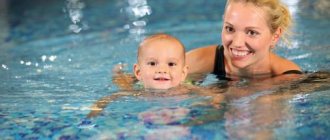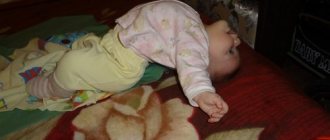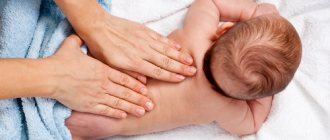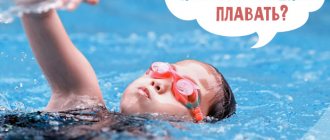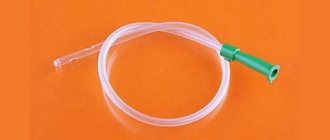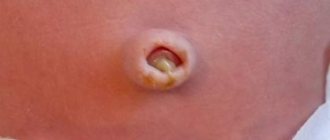Hello friends!
Exercise for newborns and its benefits for children are obvious: it helps to lose muscle tone, straighten legs and arms, and the mother’s touch will delight the baby.
After 9 months in the womb, spent in rather limited conditions (in the last 2 months before birth, the situation was especially tense), there is nothing surprising in the physiological muscle hypertonicity, which is normal for all newborns. Gymnastics helps to quickly get rid of excess tension in the muscles, the child gains the ability to grow and develop physically more comfortably.
Gymnastics is not just a series of exercises. In any case, the child sees it differently: for him it is the ability to make tactile contact with his mother. Its absence or defect leads to poor sensory development of the child and to a slowdown in psychological development.
Gymnastics improves blood circulation, which has a huge impact on appetite, digestion and sleep properties: children sleep more deeply and peacefully. Muscles develop, joints and ligaments become stronger. The child will definitely need all this when he begins to master turning over, crawling, and walking.
Dr. Komarovsky, whose worldview carries weight with many mothers, believes that exercise and strengthening from day one are the key to awakening and maintaining immunity in the future.
Criteria for activities with a child
A newborn has a strictly regulated daily routine, so it is advisable to choose a special time for physical exercise. It's better if it's the first half of the day. If he goes out to exercise at the same time, he will develop a reflex, at which time the child will not be demanding. Some criteria to follow throughout the year:
- Before starting gymnastics or massage with a newborn, mothers should thoroughly rinse and warm their hands. The room temperature should be 20 degrees. Before morning exercises, it is necessary to warm up the child’s muscles with a light massage.
- Exercises should be done an hour before feeding. The total duration of the exercises is 15 minutes.
- You need to talk while charging. If your child starts to get tired, stop exercising.
It happens that dynamic exercises are contraindicated for a child. In this case, you can simply stroke the body.
Basic rules of gymnastics for infants
Naturally, a newborn baby needs a more delicate approach in absolutely everything. In order for gymnastics to bring only benefits, this process must be treated carefully and carefully. There are several simple rules thanks to which you can achieve maximum effect from exercises:
1 Realistically assess the child’s abilities. The main goal of gymnastics is still stimulation and skill development, and not serious sports training. Take your time, choose exercises that are appropriate for your baby’s age. If you see that the child cannot cope with the load, reduce the amount of time allotted for training, reduce the intensity of the actions performed.
2 You should not start gymnastics if you are not in the mood. Exercises with your child should be interesting and desirable, and not a boring routine procedure.
If you feel that you are tired enough today, then it is better to take a day off than to once again spoil the mood for yourself and your baby.
Approach the exercises exclusively with a positive attitude and the child, like the best unbiased psychologist, will definitely reciprocate your feelings. The same applies to the child - if the baby wants to rest and is capricious, you should not force him.
3 It is advisable to develop a training regimen. The ideal time to practice with your baby is midday. By this time, the baby should be well-fed and ready to exercise, but at least 20-30 minutes should have passed since the last feeding.
Postpone gymnastics classes if your child is not healthy. Also, exercises should not be performed for several days after vaccinations.
5 Ventilate the room well before gymnastics, but also monitor the air temperature in the room. The exercises will be much more effective if the baby is naked during them, so temperatures below 22-23 degrees are not acceptable for exercise.
Contraindications
Before doing dynamic exercises for your child, you should contact your pediatrician.
After all, there are a number of contraindications:
- hip dysplasia and other diseases of the musculoskeletal system;
- dysfunctions of the cardiovascular system;
- intracranial pressure and some diseases of the nervous system;
- muscle hypertonicity.
Perform the exercises correctly, without sudden movements, because even in the absence of contraindications, you can damage the weak joints of the newborn.
How are gymnastics beneficial for infants?
In the first months of life, the baby spends most of his time sleeping: while he is just gaining strength in order to actively explore the world around him. Therefore, gymnastics in combination with children's massage is an excellent way to keep the child's muscles in good shape.
Let's look at what else is useful in gymnastics:
1 Development of coordination of movements . By about 1-2 months, the baby begins to make coordinated movements with his hands, and by 3 months, he begins to consciously and with interest feel objects around him. And by 6-7 months, you can already notice how the baby maintains balance in a sitting position, without your help.
Thus, the child confidently overcomes many stages in order to take his first independent steps. The correct formation of the musculoskeletal system occurs precisely thanks to a set of exercises for developing balance (for example, exercises on a fitball).
2 Improving the functioning of the gastrointestinal tract . Physical exercise has a beneficial effect not only on muscles, but also on the functioning of internal organs. In particular, movement ensures a healthy appetite, better digestion of food, and reduces the likelihood of gastric disorders and colic.
3 Speech development . As a rule, during gymnastics, the mother voices her actions, communicates with the child, praises him and encourages him in every possible way.
Auditory perception of sounds helps the baby form his own idea of speech. The child imitates his mother, thereby acquiring the very first speech skills.
4 Improving blood circulation and metabolism . Any movement promotes proper blood circulation throughout the body and, as a result, normalization of the heart and blood vessels. Gymnastics at an early age will help avoid the development of diseases and abnormalities associated with blood pressure. Also, the flow of blood to the soft tissues has a positive effect on growth.
5 Communication, development of tactile sensations . During gymnastics, there is direct contact between mom or dad and the child: both tactile and visual. Joint activities provide an opportunity to get to know each other better and make the child feel that he is important to his parents. This calms the child and has a beneficial effect on sleep and the nervous system as a whole.
Interesting! When does a baby start crawling? Norms and exercises
Types of gymnastics
Gymnastics for newborns can be divided into therapeutic, traditional, dynamic (including children's yoga).
Therapeutic gymnastics is manifested by severe hypertension, congenital dislocation of the foot, crank and other disorders. Gymnastics for hip dysplasia in newborns is an integral part that helps stabilize the joint and restore the normal level of movement in it. Only masters with medical knowledge can perform it. Even if the mother does the exercises and has learned the tricks, they cannot be used without the help of others so as not to harm the child.
Attention! These exercises must be performed very carefully.
The same people can do traditional or preventive gymnastics with a newborn. Includes light stroking, rubbing, mixing, spreading, bending limbs, helping to develop new skills. Fitball exercises also come here.
Recommended movements for children:
- up to 2 - stroking the baby’s limbs, belly, forming attachment, establishing tactile contact, preventing colic.
- 2-3 - massage of fingers, toes, palms. Lying on your stomach, stroking your back and shoulders.
- 4 - abdominal massage, increased range of motion of the limbs, inversion, which provides the ability to follow the object while keeping the head and shoulders in the original position.
- 6 - exercise while sitting with support.
Dynamic gymnastics is a rather extreme method of physical development for children, which was first discussed in the 1980s. It is based on a large number of movements, the active inclusion of the vestibular apparatus. Unlike traditional gymnastics, which is performed in a lying position, dynamic exercises contain inversions.
Supporters of this development of children believe that dynamic gymnastics not only develops a child on a physical level, but also accelerates his adaptation to the world around him and gives him self-confidence. With such exercises, the risk of injury increases. To avoid harm to the child, classes are conducted under the supervision of an instructor. It is best if this is a doctor with special training.
Gymnastics is carried out for 2 months. As the baby gains weight, his ligaments and muscles become stronger. If you perform a series of exercises with an untrained six-month-old baby, injuries are inevitable.
Gymnastics for a month old baby
If the baby is only a few weeks old, the choice of exercises is correct. The main rule is to do no harm.
At this age, most children experience muscle hypertension, so exercise for newborns should be focused on relaxation.
You can use the following exercises:
- Raise your arms to the sides and cross them over your chest.
- Raising handles up and down (mill).
- Raise your legs to the sides and bring them back.
- Rotate on foot, outlining a semicircle.
- Exercise “Book” (bend the child’s legs at the knee, bring them together and lift them, imitating the closing and opening of a book).
- Lying on your stomach, encouraging your baby to raise his head.
Any exercise can be repeated 5 times. All movements must be performed in an orderly manner and without breaks. Next, finish the exercise with a small massage: the arms, legs and body of the child. Massage should be given the same amount of time as gymnastic exercises.
Exercises lying on the stomach for a child up to 3 months
Lying on your stomach. As in the past, this exercise is based on reflex movements of a defensive nature. At an early age, when a baby lies on his stomach (and in fact, when he changes his body position), he tries to balance himself and then tilts his head in the direction opposite to the position of his body. The exercise is very simple: place the baby on his stomach and leave in this position for a few seconds. At the same time, be careful to keep your baby's legs apart and support his hands on his forearms.
Exercises develop the cervical and thoracic spine, strengthen the back muscles, and promote the correct and timely development of the cervical spine. Like abdominal massage, this exercise can be performed in addition to gymnastic complexes. This can be done before any breastfeeding.
Back massage . Stroking the back is performed from the back of the hand of one or both hands from the buttocks to the head along the spine. The child is on his stomach, the back of the hand is in the sacrum area, and the movement is performed along the front of the head. Return to the starting position of the hand - palmar surface. The technique of stroking the back surface is quite strong, so be sure to check the strength so as not to displease the child. You can repeat the movement 7-8 times.
The exercises stimulate the spinal muscles, in particular, have a positive effect on the back extensors and prepare the back for the following exercises.
Reflex extension of the spine . The exercise is based on the natural skin reflex of the back. To perform the procedure, you must place your baby on his side. Hold the child by the legs with one hand, and with two fingers, pressing lightly, move along the spine from bottom to top, from the sacrum to the neck. The child immediately straightens his back. Turn the baby over to the other side and do the same. The number of repetitions should start with 2 on both sides and gradually increase to 6-8.
Physical exercise intensively develops the back muscles, in particular, contributes to the formation of correct posture and strengthens the ligamentous apparatus of the spine. This can be done several times a day, with the exception of the gymnastics complex during changing clothes and other hygiene procedures.
Acupressure of the buttocks. Massage of the buttocks is performed while lying on your back. The pads of the fingers (palms are enough) are located along the inner edge of the folds of the buttocks. Start by lightly stroking upwards and to the sides.
Make several such movements (5-6), then carefully, placing your palms on the buttocks, move them 2-3 times from the front from bottom to top. A targeted blow is achieved by lightly pressing the pads of the fingers (10-12 times) just below the center of the buttocks. With timely intervention, carefully monitor the child’s mood, as it can cause a negative reaction.
This massage strengthens muscles, helps reduce increased tone, and prepares the child for a sitting position. The acupressure effect improves conductivity in the nerves of the lower extremities, tones the muscles and ligaments, and stimulates blood circulation.
Foot massage . Foot massage at this age consists of stroking. Hold your baby's foot with one hand and use the pads of your fingers or the palm of your other hand to stroke the front of the foot from the foot to the buttock, placing the main emphasis on the back (flexion) and the sides of the legs. It is necessary to make 7-8 movements on each leg. If desired, this can be done by wrapping your thumb and index finger around your leg.
Exercises reduce flexor tone, increase blood circulation in the skin and subcutaneous tissues, stimulate motor activity and sensitivity of the lower extremities.
Crawling . Place your baby on your stomach, spread your knees and bring your legs together. Clean without touching the feet, grasp the bottom of the baby's feet, then touch the soles with your thumbs. In response to your actions, the child will stretch his legs and, pushing off, move forward. Do not forget that the hands must be fixed on the table, otherwise the child will not move forward. It is necessary to perform 2-3 movements, their number must be gradually increased to 7-8.
Exercises strengthen and intensively develop the muscles of the legs and lower back, prepare the child for crawling and development of the vestibular apparatus.
"Intersection". Take the child by the arms and lift him above the table so that his feet touch the surface. Touching the table with your feet triggers a reflexive step response. If you tilt the child forward a little, then “he will go away.” While performing the exercise, try not to crush the chest, keep the baby suspended and make sure that the leg is in full contact with the surface of the table. The exercise can be performed both in front and on you. This must be done before the child shows signs of dissatisfaction or lethargy.
Exercises develop the vestibular apparatus, lengthen the spinal ligaments and paravertebral muscles, gently stretch the leg muscles and reduce tone, and also teach the child to maintain an upright position.
"Slide on the back" . Place the baby on his back, bend his arms and legs, holding his stomach with one hand. The baby will be in his favorite position - the “fetal position”. 2nd hand to support the head. Gently, holding hands and feet, rock the child from side to side, back and forth, in a circle. Make 2-3 movements in any direction.
This exercise develops the ligamentous apparatus of the back, has a positive effect on the vestibular apparatus, strengthens the extensor muscles and promotes the correct formation of thoracic torsion of the spine.
"Shaking hands" . After active exercises, you should relax your baby a little and calm his nervous system. Place your baby on his back, hold your hands (your thumb should be on his palm), stretch your arms out to the sides and shake them slightly. If the child resists this action (which may have a higher tone than the flexors), then before training it is recommended to repeat stroking the arms to relieve tension.
This is the main complex used up to 2.5 months of age. After starting the exercises, you can add your own exercises and movements that your child likes to the complex. Try not to do anything difficult: if your child doesn't do some of the exercises, you shouldn't give it up altogether.
Check back in a week or two. Place a lot of emphasis on exercises that make your child feel good (they can be done with lots of repetition), but don't forget that you must complete all the exercises.
Gymnastics with newborns for joint development
Gymnastics for the first month of newborns necessarily includes passive exercises for the joints.
Exercise 1: Cross your arms over your chest and move them to the sides. Designed for children 3-4 months old. The starting position of the child is lying on his back. Hold the baby's hands with your hands. Bring the child's arms to your chest, as if hugging him (to cross the child's arms on the chest), then, extending the elbow joints, bring it to the sides at shoulder level to the height of the table surface. Repeat 4-6 times.
Exercise 2: flexion and extension of the arms at the elbow joints. Designed for children from 4-6 months. The starting position when performing this gymnastics exercise for newborn joints is lying on your back. Take your baby's hand and alternately bend and extend your baby's arms to chest level. Repeat 4-6 times.
Exercise 3: Clap your hands. Designed for children from 6-9 months. Starting position: lying on your back. Take the child by the hand, his arms should be fully extended to the elbow joints (straightened). Raise your arms forward and up (clap your hands) and place them at your sides until they touch the surface of the table. Repeat 4-6 times.
What other exercises should you do with your newborn for joint development?
Exercise 4: simultaneous and alternate flexion and extension of the legs. Designed for children from 4-6 months. Starting position: lying on your back. Place the child's arms along the body, arms around the legs. When doing such gymnastics for a newborn, it is advisable to slowly and carefully bend the child’s legs at the knee and hip joints, slightly lifting the legs, twisting them on the stomach. Slowly lower your legs to the starting position. Flexion and extension together 3-4 times, then flexion and extension 3-4 times alternately.
Exercise 5: “trample.” Designed for children from 4-6 months. The starting position of the child is lying on his back. Grab your child's ankles, bend their legs, and push their legs onto the table. Alternatively, fold your child's legs without removing them from the table. Repeat 8-10 times.
Exercise 6: Raising straight legs. This newborn development exercise is intended for children 4-6 months old. Starting position: lying on your stomach. With your left hand, take the child from both ankle joints, and with your right hand, secure the lower back. Lift your child's body slightly off the table, then lower him to the starting position. Repeat 3-4 times.
Exercise 7: Move your arms to the sides and lower them. Designed for children from 6-9 months. Starting position: lying on your back. Take your child by the arms, arms out to the sides until they touch the surface of the table, then, sliding along this surface, lower your arms to touch the body. Repeat 4-6 times.
Exercise 8: Alternately raise and lower your arms. Designed for children from 6-9 months. Starting position: lying on your back. When doing this exercise for newborns, it is advisable to take the child by the straightened arms, raise one hand to the level of the head until it touches the table, lower the other down to touch the body and the table, Repeat 2-4 times.
Exercise 9: hand movements. Designed for children from 6-9 months. Starting position - lie on your back, arms along your body. Hold your child's hand and make circular movements with your arms straight. Repeat 4-6 times.
Exercise 10: Shoulder abduction with shoulder blade reduction. Designed for children from 6-9 months. Starting position: lying on your stomach. Gently spread the child's arms to the sides, bend the elbow joints and move the shoulders back, bringing the shoulder blades together. Repeat 2-3 times.

